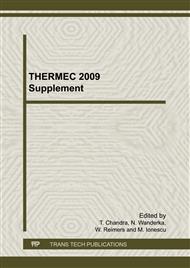[1]
J.R. Rice and R. Thomson: Philos. Mag. Vol. 29 (1974), p.73.
Google Scholar
[2]
R. Thomson: Philos. Mag. A Vol. 75 (1997), p.749.
Google Scholar
[3]
R. Thomson: J. Mater. Sci. Vol. 13 (1978), p.128.
Google Scholar
[4]
J. Weertman: Acta Metall. Vol. 26 (1978), p.1731.
Google Scholar
[5]
B.S. Majumdar and S.J. Burns: Acta Metall. Vol. 29 (1981), p.579.
Google Scholar
[6]
R. Thomson, in: F. Seitz and D. Turnbull (Eds. ), Solid State Physics, vol. 39, Academic Press, INC., Orlando, San Diego, New York, Austin, Boston, London, Sydney, Tokyo, Toronto, 1986, p.1.
DOI: 10.1002/abio.370060416
Google Scholar
[7]
V. Bulatov, F.F. Abraham, L. Kubin, B. Devincre and S. Yip: Nature Vol. 391 (1998), p.669.
DOI: 10.1038/35577
Google Scholar
[8]
K. Higashida, N. Narita, M. Tanaka, T. Morikawa, Y. Miura and R. Onodera: Philos. Mag. A Vol. 82 (2002), p.3263.
Google Scholar
[9]
M. Tanaka, K. Higashida, T. Kishikawa and T. Morikawa: Mater. Trans. Vol. 43 (2002), p.2169.
Google Scholar
[10]
K. Kaneko, R. Nagayama, K. Inoke, W. -J. Moon, Z. Horita, Y. Hayashi and T. Tokunaga: Scripta Mater. Vol. 52 (2005), p.1205.
DOI: 10.1016/j.scriptamat.2005.03.007
Google Scholar
[11]
K. Kimura, S. Hata, S. Matsumura and T. Horiuchi: J. Electron Microsc. Vol. 54 (2005), p.373.
Google Scholar
[12]
P.A. Midgley and M. Weyland: Ultramicroscopy Vol. 96 (2003), p.413.
Google Scholar
[13]
K. Kaneko, K. Inoke, K. Sato, K. Kitawaki, H. Higashida, I. Arslan and P.A. Midgley: Ultramicroscopy Vol. 108 (2008), p.210.
DOI: 10.1016/j.ultramic.2007.04.020
Google Scholar
[14]
K. Kaneko, K. Inoke, B. Freitag, A.B. Hungria, P.A. Midgley, T.W. Hansen, J. Zhang, S. Ohara and T. Adschiri: Nano Lett. Vol. 7 (2007), p.421.
DOI: 10.1021/nl062677b
Google Scholar
[15]
J.S. Barnard, J. Sharp, J.R. Tong and P.A. Midgley: Science Vol. 313 (2006), p.319.
Google Scholar
[16]
J.H. Sharp, J.S. Barnard, K. Kaneko, K. Higashida and P.A. Midgley: J. Phys. Conf. Ser Vol. 126 (2008), p.012013.
Google Scholar
[17]
M. Tanaka, K. Higashida, K. Kaneko, S. Hata and M. Mitsuhara: Scripta Mater. Vol. 59 (2008), p.901.
Google Scholar
[18]
http: /www. melbuild. com.
Google Scholar
[19]
M. Imai and K. Sumino: Philos. Mag. A Vol. 47 (1983), p.599.
Google Scholar
[20]
K. Higashida, T. Kawamura, T. Morikawa, Y. Miura, N. Narita and R. Onodera: Mater. Sci. Eng., A Vol. 319-321 (2001), p.683.
Google Scholar
[21]
M. Tanaka, K. Higashida and T. Haraguchi: Mater. Sci. Eng., A Vol. 387-389 (2004), p.433.
Google Scholar


